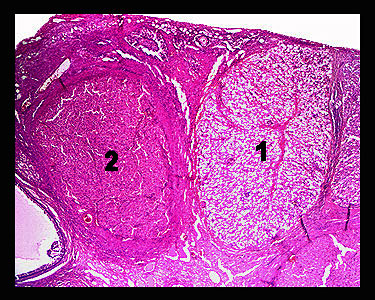|
|
|
|
||||||||||||||||||||||||||||||||||
|
This section of a mature cat ovary shows a newly-formed corpus luteum and one that is regressing. Following ovulation, the mature follicle is traumatized and forms a bloody scar called the corpus hemorrhagicum. This stage is very transitory and is not usually observed on slides. Under the influence of pituitary hormones, the stratum granulosum cells proliferate and form luteal cells. These luteal cells fill the old follicular antrum, and the structure is now termed a corpus luteum. The luteal cells of the corpus luteum produce the hormone progesterone. Eventually, the corpus luteum becomes smaller and non-functional, leaving only a small mass of scar tissue called the corpus albicans (not seen on this slide). |
|
